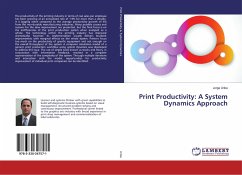The productivity of the printing industry in terms of real sales per employee has been growing at an annualized rate of 1.9% for more than a decade. It is lagging when compared to the average productivity growth of 4% from the non-durable manufacturing industries. Many possible causes and reasons for the slow improvement are presented, but the final focus is on the inefficiencies of the print production system when analyzed as a whole. The technology within the printing industry has improved dramatically; however, its implementation usually delivers localized improvements with marginal effects on the whole system. Printers focus too much on the productivity of specific equipment and not enough on the overall throughput of the system. A computer simulation model of a generic print production workflow using system dynamics was developed to address this issue. The use of simple tools known as stocks and flows, in conjunction with information feedback, resulted in a complete representation of the complexity of the system. Through multiple iterations and interaction with the model, opportunities for productivity improvement of individual print companies can be identified.








